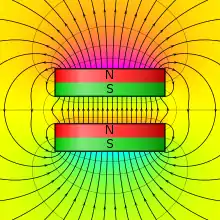Magnetic scalar potential
Magnetic scalar potential, ψ, is a quantity in classical electromagnetism analogous to electric potential. It is used to specify the magnetic H-field in cases when there are no free currents, in a manner analogous to using the electric potential to determine the electric field in electrostatics. One important use of ψ is to determine the magnetic field due to permanent magnets when their magnetization is known. The potential is valid in any region with zero current density, thus if currents are confined to wires or surfaces, piecemeal solutions can be stitched together to provide a description of the magnetic field at all points in space.
| Articles about |
| Electromagnetism |
|---|
 |
Magnetic scalar potential

The scalar potential is a useful quantity in describing the magnetic field, especially for permanent magnets.
In a simply connected domain where there is no free current,
hence we can define a magnetic scalar potential, ψ, as[1]
Using the definition of H:
it follows that
Here, ∇ ⋅ M acts as the source for magnetic field, much like ∇ ⋅ P acts as the source for electric field. So analogously to bound electric charge, the quantity
is called the bound magnetic charge.
If there is free current, one may subtract the contribution of free current per Biot–Savart law from total magnetic field and solve the remainder with the scalar potential method. To date there has not been any reproducible evidence for the existence of magnetic monopoles.[2]
See also
Notes
- Vanderlinde (2005, pp. 194~199)
- Griffiths, David (2013). Introduction to Electrodynamics. Pearson. pp. 241–242. ISBN 9780321856562.
References
- Duffin, W.J. (1980). Electricity and Magnetism, Fourth Edition. McGraw-Hill. ISBN 007084111X.
- Jackson, John David (1999), Classical Electrodynamics (3rd ed.), John Wiley & Sons, ISBN 0-471-30932-X
- Vanderlinde, Jack (2005). Classical Electromagnetic Theory. Bibcode:2005cet..book.....V. doi:10.1007/1-4020-2700-1. ISBN 1-4020-2699-4.